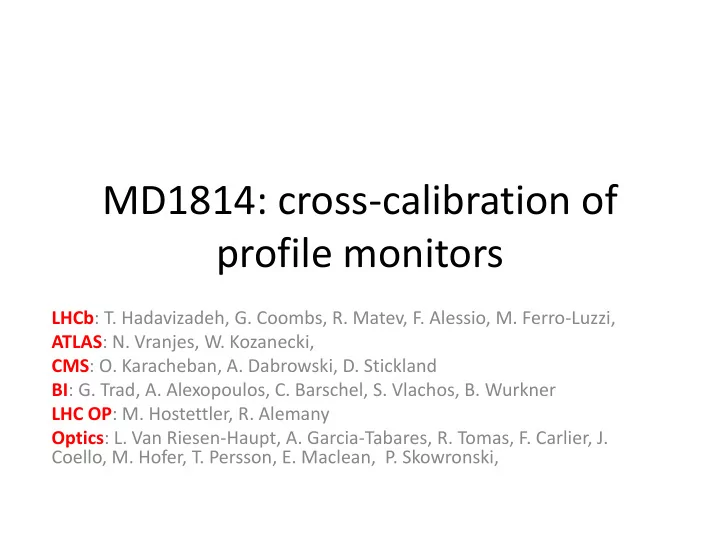

MD1814: cross-calibration of profile monitors LHCb : T. Hadavizadeh, G. Coombs, R. Matev, F. Alessio, M. Ferro-Luzzi, ATLAS : N. Vranjes, W. Kozanecki, CMS : O. Karacheban, A. Dabrowski, D. Stickland BI : G. Trad, A. Alexopoulos, C. Barschel, S. Vlachos, B. Wurkner LHC OP : M. Hostettler, R. Alemany Optics : L. Van Riesen-Haupt, A. Garcia-Tabares, R. Tomas, F. Carlier, J. Coello, M. Hofer, T. Persson, E. Maclean, P. Skowronski,
Reminder about motivation • Calibration of a transverse beam profile monitor is of fundamental importance to: • guarantee the quality of the measurement, • assure the best possible accuracy, • ensure proper working of the instrument over time. • For the first time in LHC, a dedicated cross-calibration of all the systems was carried MD1814 part 1 out with beam. • Since the beta function is a fundamental parameter in the calculation of the emittance, dedicated optics measurements were also performed in order to MD1814 part 2 determine with the highest possible accuracy the amplitude function BSRT OP scans WS LHC Calibration Standard ATLAS/CMS lumi LHCb beam & lumi region gas evolution
Lessons learnt • The cross-calibration of the BSRT w.r.t. WS strongly depends on the knowledge of the beta function at the position of the devices (ondulator @injection and D3 @flat top for BSRT) Important differences found when using the “model betas” and the “measured betas” and when using the operational calibration factors (the ones obtained with the nominal optics) or dedicated ones according to the optics. • It is important for a proper cross-calibration of the BSRT during nominal operation to measure the optics in IR4 at injection and at collisions (assuming it does not change during squeeze) request to be done for 2017 .
Lessons learnt • vdM Optics β (19,19,19,24) is not suitable for cross-calibration because β * ≅ L* k-modulation and phase advance give unreliable results and huge error bars, respectively. • An optics with big β * to get big beam sizes but β *≠ L* is needed, unfortunately might not be compatible with vdM needs which would mean a dedicated optics for the cross-calibration. Otherwise beta uncertainty is the largest of the uncertainties.
Lessons learnt • vdM optics in IR4 gives very small emittances , below 1 μm rad, never cross- calibrated before we realised this is very challenging and that the calibration curve, believed up to know to be a straight line, it is not:
Preliminary results Emittance Beam Gas vs Emittance WS Perfect agreement Linear fit Good agreement (2 to 10%) for B1V, B2H/V, but 65% disagreement in B1H NOT YET UNDERSTOOD CONVOLUTED EMITTANCES COMPARISON for WS, Beam gas, OP scan IP1&5 The disagreement reduces to 32% in H, but careful!! those are convoluted emittances, i.e. (emi_B1_H + emi_B2_H)/2
Preliminary results Ratio OP scan vs WS = f(bunch ID) 5%-15% disagreement
OP scan vs ATLAS OP scans vs CMS/ATLAS results: • OP scans vs CMS: the level of agreement depends on the fit method used, the detector used: differences range from +/-6% down to +/-3%. • OP scans vs ATLAS: disagreement of +/- 2% only. 2% discrepancy
Conclusions • Cross-calibration of BSRT vs WS strongly depends on knowledge of the beta function need to measure IR4 betas at injection and (at least) collisions for proper calibration of the BSRT during physics production • Measurement of very small emittances is a challenge calibration curve BSRT vs WS is not linear anymore . Important to study this in detail since we are aiming at very small emittances after LIU injector complex upgrade. On top of this, one day we’ll manage to understand and cure the emittance blow up during the LHC cycle. • vdM optics not suitable for cross-calibration need to find a better optics, but most likely will have to be a dedicated optics. • LHCb beam gas B1 H 65% disagreement with WS under investigation • OP scans vs WS : largest disagreement is 15% for a given bunch . • OP scans vs IP1&5 off-line measurements : largest discrepancy is with CMS , for ATLAS the agreement is very good . • We want to request another cross-calibration MD in 2017, to be solved the issue with the optics to be able to give specific time duration.
Recommend
More recommend